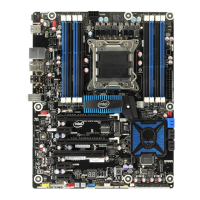
Do you have a question about the Intel DX79TO and is the answer not in the manual?
| Form Factor | ATX |
|---|---|
| Chipset | Intel X79 |
| Socket | LGA 2011 |
| Memory Type | DDR3 |
| Max Memory | 64GB |
| PCIe 2.0 x1 Slots | 2 |
| PCI Slots | 1 |
| SATA 6Gb/s | 2 |
| SATA 3Gb/s | 4 |
| USB 3.0 Ports | 2 |
| LAN | Intel 82579V |
| Memory Slots | 8 |
Provides a summary of the board's features, layout, block diagram, and technical specifications.
Details differences from other Intel Desktop Board products, such as missing parallel and PS/2 ports.
Lists Intel's website resources for product support, drivers, and configuration information.
Details processor support, wattage limits, and where to find the latest supported processor list.
Describes memory support, including DDR3 DIMMs, channels, capacity, and configurations.
Details the Intel X79 Express Chipset, its interfaces, and resources used by the chipset.
Explains the function of the coin-cell battery powering the real-time clock and CMOS memory.
Describes the I/O controller features, including Consumer Infrared (CIR) and serial IRQ support.
Details the Realtek ALC892 audio codec, jack support, and audio subsystem components.
Covers the Intel 82579L Gigabit Ethernet Controller, LAN software, and RJ-45 connector LEDs.
Explains hardware management features like fan control, thermal/voltage monitoring, and chassis intrusion detection.
Details power management implementation via ACPI, system states, and wake-up devices.
Describes the board status LEDs used for monitoring BIOS POST progress and system functions.
Explains the function and location of the onboard power and reset buttons.
Details the Nuvoton WPCT210 TPM component for enhancing platform security.
Details addressable memory, memory map, and system address space allocation.
Describes back panel and component-side connectors and headers, including I/O shield.
Explains the function of the 3-pin jumper block for BIOS setup modes (normal, configure, recovery).
Details the board's form factor, dimensions, and compliance with ATX specifications.
Covers power supply considerations, fan header current capability, and add-in board current.
Discusses chassis airflow requirements, component temperature limits, and heat zones.
Provides information on Mean Time Between Failures (MTBF) prediction.
Lists environmental specifications including operating temperature, shock, and vibration.
Introduces the Intel BIOS, its storage, update methods, and access via F2 key.
Details the Serial Peripheral Interface Flash Memory (SPI Flash) device.
Explains PCI autoconfiguration for devices and resource allocation.
Describes SMBIOS for managing system information and components in a network.
Enables USB device usage before OS USB drivers are available, for setup and OS installation.
Details utilities for updating the BIOS, including Intel Express and Flash Memory Update.
Explains BIOS recovery procedures and acceptable media types for recovery.
Covers boot device selection, optical drive boot, network boot, and POST boot device menu.
Provides techniques for improving system boot speed and BIOS boot optimizations.
Details supervisor and user passwords for restricting BIOS setup and computer boot access.
Lists BIOS options for custom performance enhancements like frequency and voltage adjustments.
Describes the board-mounted speaker for providing audible error code (beep code) information.
Lists BIOS beep codes, their patterns, frequencies, and associated error types.
Details front-panel power LED blink codes, patterns, and their corresponding error messages.
Lists common BIOS error messages and provides brief explanations for each.
Explains POST codes generated by the BIOS for diagnosing errors during the POST process.
Details safety standards, EU declarations, EMC regulations, and product ecology statements.
Provides safety warnings and instructions regarding battery replacement, recycling, and disposal.
